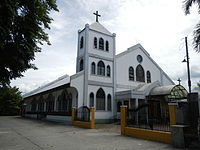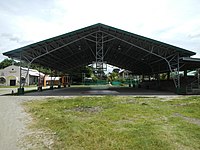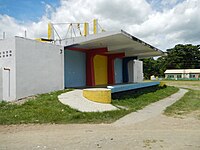San Clemente, Tarlac
San Clemente | ||
|---|---|---|
| Municipality of San Clemente | ||
 Municipal Hall | ||
 Map of Tarlac with San Clemente highlighted | ||
Location within the Philippines | ||
| Coordinates: 15°42′43″N 120°21′37″E / 15.7119°N 120.3603°E | ||
| Country | Philippines | |
| Region | Central Luzon | |
| Province | Tarlac | |
| District | 1st district | |
| Barangays | 12
(see ZIP code 2305 | |
| PSGC | ||
| IDD : area code | +63 (0)45 | |
| Native languages | Pangasinan Ilocano Tagalog Kapampangan | |
San Clemente, officially the Municipality of San Clemente (
province of Tarlac, Philippines. According to the 2020 census, it has a population of 13,181 people.[3]
Geography
San Clemente borders the provinces of Pangasinan to the north and northwest and Zambales to the west. Like Santa Ignacia and Mayantoc, it is a former part of Camiling.
San Clemente is 43 kilometres (27 mi) from the provincial capital Tarlac City and 167 kilometres (104 mi) from Manila.
Barangays
San Clemente is politically subdivided into 12
sitios
.
- Balloc
- Bamban
- Casipo
- Catagudingan
- Daldalayap
- Doclong 1
- Doclong 2
- Maasin
- Nagsabaran
- Pit-ao
- Poblacion Norte
- Poblacion Sur
Climate
| Climate data for San Clemente, Tarlac | |||||||||||||
|---|---|---|---|---|---|---|---|---|---|---|---|---|---|
| Month | Jan | Feb | Mar | Apr | May | Jun | Jul | Aug | Sep | Oct | Nov | Dec | Year |
| Mean daily maximum °C (°F) | 30 (86) |
31 (88) |
33 (91) |
35 (95) |
33 (91) |
31 (88) |
30 (86) |
29 (84) |
29 (84) |
30 (86) |
31 (88) |
30 (86) |
31 (88) |
| Mean daily minimum °C (°F) | 19 (66) |
19 (66) |
20 (68) |
22 (72) |
24 (75) |
24 (75) |
24 (75) |
24 (75) |
23 (73) |
22 (72) |
21 (70) |
20 (68) |
22 (71) |
| Average precipitation mm (inches) | 3 (0.1) |
2 (0.1) |
5 (0.2) |
10 (0.4) |
80 (3.1) |
107 (4.2) |
138 (5.4) |
147 (5.8) |
119 (4.7) |
70 (2.8) |
26 (1.0) |
8 (0.3) |
715 (28.1) |
| Average rainy days | 2.0 | 1.7 | 2.7 | 4.6 | 16.1 | 20.8 | 24.0 | 23.0 | 21.4 | 15.5 | 8.0 | 3.2 | 143 |
| Source: Meteoblue[6] | |||||||||||||
Demographics
| Year | Pop. | ±% p.a. |
|---|---|---|
| 1903 | 1,822 | — |
| 1918 | 2,654 | +2.54% |
| 1939 | 3,199 | +0.89% |
| 1948 | 4,392 | +3.58% |
| 1960 | 5,337 | +1.64% |
| 1970 | 6,073 | +1.30% |
| 1975 | 7,406 | +4.06% |
| 1980 | 7,117 | −0.79% |
| 1990 | 8,873 | +2.23% |
| 1995 | 11,105 | +4.29% |
| 2000 | 11,703 | +1.13% |
| 2007 | 12,458 | +0.87% |
| 2010 | 12,510 | +0.15% |
| 2015 | 12,657 | +0.22% |
| 2020 | 13,181 | +0.80% |
| Source: Philippine Statistics Authority[7][8][9][10] | ||
In the 2020 census, the population of San Clemente, Tarlac, was 13,181 people,[3] with a density of 270 inhabitants per square kilometre or 700 inhabitants per square mile.
Economy
Poverty Incidence of San Clemente
Graphs are unavailable due to technical issues. There is more info on Phabricator and on MediaWiki.org. |
Tourism
- San Clemente Municipal Hall
- Saint Jude Thaddeus Parish Church of San Clemente
- Canding Falls
- Ubod Falls
- San Clemente Food Park
Gallery
|
References
- (DILG)
- (PDF) from the original on May 25, 2021. Retrieved July 16, 2021.
- ^ a b c Census of Population (2020). "Region III (Central Luzon)". Total Population by Province, City, Municipality and Barangay. Philippine Statistics Authority. Retrieved 8 July 2021.
- ^ "PSA Releases the 2018 Municipal and City Level Poverty Estimates". Philippine Statistics Authority. 15 December 2021. Retrieved 22 January 2022.
- ^ "Province: Tarlac". PSGC Interactive. Quezon City, Philippines: Philippine Statistics Authority. Retrieved 12 November 2016.
- ^ "San Clemente: Average Temperatures and Rainfall". Meteoblue. Retrieved 5 May 2020.
- ^ Census of Population (2015). "Region III (Central Luzon)". Total Population by Province, City, Municipality and Barangay. Philippine Statistics Authority. Retrieved 20 June 2016.
- ^ Census of Population and Housing (2010). "Region III (Central Luzon)" (PDF). Total Population by Province, City, Municipality and Barangay. National Statistics Office. Retrieved 29 June 2016.
- ^ Censuses of Population (1903–2007). "Region III (Central Luzon)". Table 1. Population Enumerated in Various Censuses by Province/Highly Urbanized City: 1903 to 2007. National Statistics Office.
{{cite encyclopedia}}: CS1 maint: numeric names: authors list (link) - ^
"Province of Tarlac". Municipality Population Data. Local Water Utilities AdministrationResearch Division. Retrieved 17 December 2016.
- ^ "Poverty incidence (PI):". Philippine Statistics Authority. Retrieved December 28, 2020.
- ^ "Estimation of Local Poverty in the Philippines" (PDF). Philippine Statistics Authority. 29 November 2005.
- ^ "2003 City and Municipal Level Poverty Estimates" (PDF). Philippine Statistics Authority. 23 March 2009.
- ^ "City and Municipal Level Poverty Estimates; 2006 and 2009" (PDF). Philippine Statistics Authority. 3 August 2012.
- ^ "2012 Municipal and City Level Poverty Estimates" (PDF). Philippine Statistics Authority. 31 May 2016.
- ^ "Municipal and City Level Small Area Poverty Estimates; 2009, 2012 and 2015". Philippine Statistics Authority. 10 July 2019.
- ^ "PSA Releases the 2018 Municipal and City Level Poverty Estimates". Philippine Statistics Authority. 15 December 2021. Retrieved 22 January 2022.
- ^ "PSA Releases the 2021 City and Municipal Level Poverty Estimates". Philippine Statistics Authority. 2 April 2024. Retrieved 28 April 2024.
External links
Wikimedia Commons has media related to San Clemente, Tarlac.
- San Clemente Profile at PhilAtlas.com
- Philippine Standard Geographic Code
- Philippine Census Information










